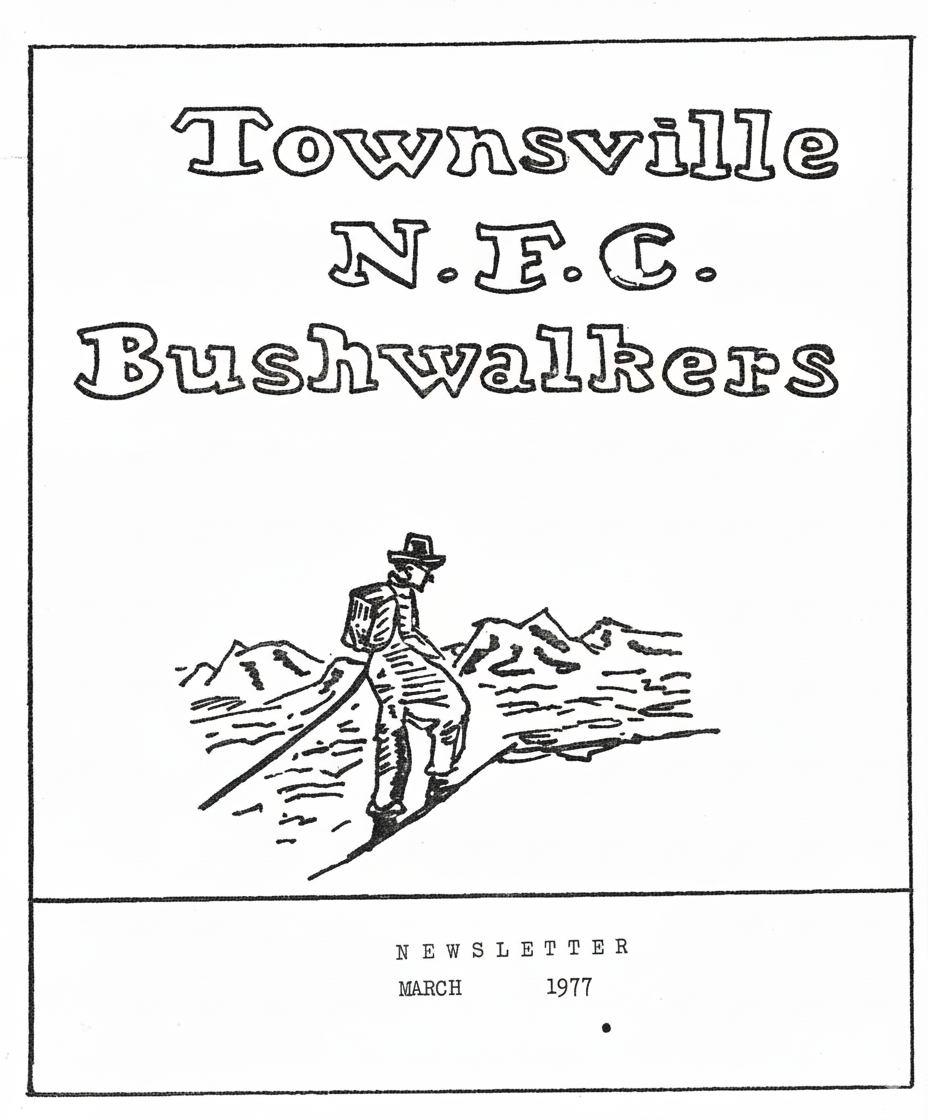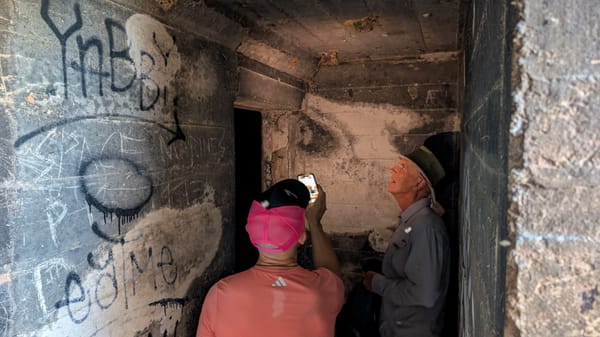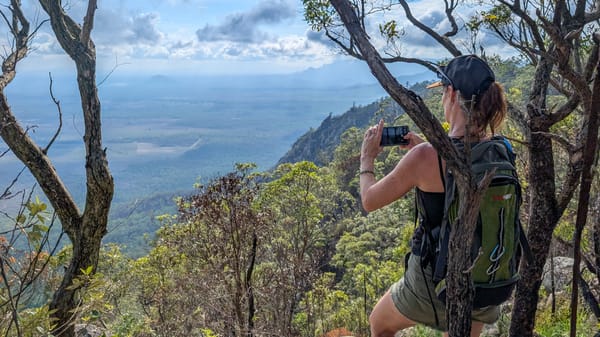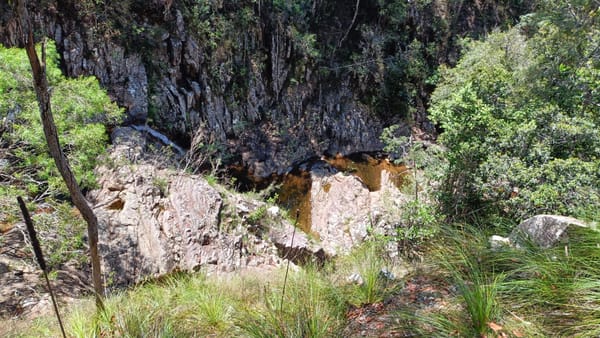TNFC Newsletter - March 1977
Relive the March 1977 Townsville N.F.C. Bushwalkers newsletter with classic trip reports, conservation notes, and adventures across North Queensland. Highlights include Tully Gorge, Cape Cleveland, Mt Bartle Frere, and Porcupine Gorge—plus the 1977 hike programme and early environmental advocacy.

Townsville N.F.C. Bushwalkers
NEWSLETTER
MARCH
1977
TOWNSVILLE N.F.C. BUSHWALKERS CLUB
P.O. Box 494
TOWNSVILLE.
Qld. 4810.
Hon.Officers:
PRESIDENT Ron Ninnis
VICE-PRESIDENT Liz McLeod
SECRETARY Lilly Marcellos
TREASURER
EQUIPMENT OFFICER Debbie Edwards
SAFETY TRAINING OFFICER Andy Plunkett
EDITOR Roy Williams
ASSISTANT EDITOR Les Hyland
CONTACT OFFICER Marion Darveniza
22, Banksia Street,
KIRWAN, 4814.
NOTE : New Phone No. 731074
Meeting Place:
The National Fitness Centre,
Cleveland Terrace (Side Entrance)
Opposite the old Supreme Court.
Alternate Wednesdays 20.00 hrs.
See list of meetings opposite.
**** TRIP PROGRAMME ****
1977 FIRST PART
March 19/20 WE Dalrymple Track & Mt.Westminster Abbey G.Wells $ 3.80
April 8/11 LWE Porcupine Gorge & D.Edwards 8.20
(Easter) White Mountain
April 17 D Alligator Creek L.Hyland 1.50
April 23/25 LWE Cape Upstart L.McLeod 4.60
April 30/ LWE Hinchinbrook Island A.Baker 4.10
May 2 (+ boat cost)
May 15 D Mount Halifax. L.Darveniza 1.30
May 28/29 WE Red Falls A.Plunkett 4.60
June 11/13 LWE Lava Tunnels R.Williams TBA.
June 26 D Frederick's Peak R.Ninnis 1.00
July 9/10 WE Mt.Bartle-Frere T.Kelly 6.80
July 24 D Big Bend M. Richardson 3.90
T.B.A D Abseiling(Safety Training) A.Plunkett
GENERAL MEETINGS
March 16 A.G.M.
April 13
May 11
June 8
July 6
August 3
SOCIAL MEETINGS
March 30
April 27
May 25
June 22
July 20
August 17
"A STRANGER IN PARADISE" Alma Strapazon
Some time ago this Victorian entered the Sunshine State, to find a different world - a world full of colourful flowering trees, exotic fruits, idyllic beaches and green green rainforests.
The little old Volkswagen veered drunkenly from side to side of the road as the conversation repeated itself:-
"Oh look! Just look at all the bananas!"(mangoes, pineapples, coconuts, paw-paws)
"Oh look! Just smell those bauhinias!"(sugar-cane, frangipani, etc.etc.)
Eventually the novelty of all this lush growth wore off a little, we tired of being tourists and that old yearning for the solitude and silence of the bush made itself felt again. Settled temporarily in Townsville, I soon booked myself on a walk and the next Sunday found me bleary-eyed and staggering by the 5.00 hrs meeting time.
It turned out to be a little later than that - Townsville Time ? - before the leader had gathered together his flock. We arrived at the Herbert River to join another group who had camped there overnight their original intention being to make an early start and precede us up Garrawalt Creek to the falls.
Both groups set off upstream together and it was not long before the pretty creek was inviting us into its lovely pools. Not so, however! Our leaders would allow of no tarrying, so it was onward ever upstream, rock hopping until we reached the falls. These are most dramatically situated in a forested gorge, the creek tumbling mistily down the rock-face to fall gently into a limpid pool.
Some time was spent admiring and photographing the two falls; so spectacular in their wild setting. Then it was all into the refreshing water, for there is nothing like a cool swim to perk up an appetite ! We ate a leisurely lunch, baking in the sun on the hot rocks, while the wiser ones took refuge in the shade of a rocky overhang.
Later, some found energy enough to climb up the rock face to the top of the falls - an exhilarating if scratchy diversion. Half way up the climb there is a large deep pool contained within a circle of boulders. This is the place for a really cool swim before the final scramble to the top. Crimson bottlebrush mirrored itself in the clear waters. Large black and white and the brilliant blue butterflies fluttered about claiming all our attention.
In such surroundings one would wish to go on for ever delighting in each rock-bound pool, and in each sparkling cascade, but time was rushing on and reality dampened that irrepressible bushwalkers' urge to go on "just around the next bend ". Reluctantly we descended ; another quick dip in the pool and off again, the last of our group to depart from that beautiful place .
The pleasure of being on the track again, the informality and friendliness of the walkers had made me feel at home. Then, surprise, surprise, it was discovered that Ron had been a walking companion of mine down south three years ago.
Still in Paradise, I was a stranger no more !
§ * * * * * * * *
THE ENVIRONMENT NEEDS YOU:
Join The Townsville Regional
Conservation Council NOW
"Mount Bartle Frere"
Darryl Wright.
It was on Friday night at Gaylynglen that the hesitation of some, brought about by the inclemency of the weather in that region, was surmounted and a party of sixteen set out for the site chosen for the overnight camp.
After breaking camp early in the morning we then proceeded a short way by cars to the foot of the mountain where the visitors book was signed by those who were to partake in the climb. A well defined path from the miner's camp was followed in single file as we nimbly avoided the thorns on the wild rasberries that enclosed the path. Suddenly, at the first clearing where we deleached ourselves for the first,but not the last,time, these raspberries relented to the forest trees which deprived t them of their light.
Rapid progress was made along a ridge which rose sharply following the Russell towards the peak. The laborious, tiresome plod to the top was alleviated only when a cool breeze was diverted upwards by the ridge. The large overhanging rock was greeted with sighs of relief as the weary walkers rested during lunch. From the rock, the surrounding terrain was explored as different sections were identified.
After an hour's break the gathering pressed on to surmount the remainder of the day's walk. The final leg of the excursion was to take about three hours bringing the walking time to six hours. The latter section of the walk is the most interesting as we ascend through the eerie mist which imparts a feeling of quietness and isolation to those who invade. The trees appear to stoop as they are laden with drooping moss drapes from their boughs.
Finally after traversing from the two plateaux, Elizabeth and I were rewarded by a breath-taking view of the region which was obscured in areas by the billowing clouds which drifted by Within five minutes these clouds obliterated the landscape from us again. Because of its proximity to water, camp was erected at the old miners' hut. Slowly, the clouds beseiged us, making an attempt on the summit impossible and leaving exposed areas moist and cold. The night was disappointing as were unable to sight the setting sun through the swirling mass driven by the increasing winds. A rough long night was spent by all as we attempted to sleep in the madly flapping tents blown about by the ferocious wind and pelting rain.
Early morning was no better as one woke feeling quite miserable and wet. Ten of the hardier bushwalkers set off to make the top and to nail a plate to a tree. It wasn't long after their departure that the sun lifted the shroud to offer to the triumphant group the beauty of the environment.
The descent took half of the time required for the ascent as we stepped out energetically knowing that it would be climaxed by a plunge at the Josephine Falls.
EQUIPMENT FOR HIRE
The following equipment can be hired by members for the charge shown. Contact the Club equipment Officer.
4 Sleeping Bags 60c each
2 H Packs 20c
2 A Packs 20c
4 Frameless Packs 20c
4 New Packs 20c
1 Blanket 20c
2 Groundsheets 20c
3 Two-man tents(2 floored, 1 not) 60c
1 Four-man tent 60c
1 Flying Suit 20c
Climbing Rope & Crabs $ 1:00
One of the earliest environmentalists was the Spanish king who sent an Armadillo to England in 1588. (Ed.)
TULLY GORGE
The Tully Gorge/Tully Falls, rate as one of the finest bushwalking gorge trips in North Queensland.
DURATION:
(1) As a one (1) day trip from Kareeya Power Station, up the Gorge to the top of the falls, and back to the Power Station, approx. 12 hours assuming a fit party and good conditions.
(2) An easy two (2) day trip (one day energetic rock-climbing). Start Kareeya Power Station, camp at top of the Falls, return via Power Station access tracks.
TIME OF YEAR:
The Tully River is diverted through the Power Station and no longer has a normal flow in the section from the Falls down to the Power Station. However, after the wet season, side creeks flowing into the Gorge, create an appreciable flow.
The best time of year is roughly between August and the onset of the wet (December to February). Unfortunately, this generally coincides with the hot period of the year and March-fly season.
Because of slippery rocks, the Gorge is best avoided during the wet season.
ROUTE GUIDE: (From Map and following Comments):
A. Enter the Gorge at the Power Station.
*N.B. Advise the Power Station Control Room Operators of your intentions as on occasions water is released into the Gorge. (The opportunity exists for inspecting an interesting Power Station).
Simply follow nose up river bed. The river bed consists of numerous boulders and pools.
B. The Gorge narrows markedly and large rocks (presenting a barrier) appear. These can be passed by climbing over the top about one-third from the L.H. side. Time – approx. 2 (two) hours to this point.
C. After surmounting obstacle B, a large pool is found and also a large and obvious cave containing Grey Swiftlets. The route then is followed by climbing some 50 ft over and above the cave on the R.H. side, and re-entering the Gorge.
D. More very large rocks easily crossed on R.H. side where a small Swiftlets cave may be found.
E. The Gorge narrows to a large chock-stone and pool. The pool must be swum and climbed on the R.H. side of the chock-stone.
F. Boulders, house-size, passed by much trial and error (caving in a river bed).
G. Large Swiftlets cave at bottom of the Falls. The way is found onto a razor back ridge by following round a rock corner facing the Swiftlets cave and making a simple ten foot rock climb.
The ridge, forestry tracks, and road tracks for return to the starting point (as marked on the map) are easily followed. The ridge is delightfully steep with plentiful botanical hand-holds.
The Gorge Lookout is worth a visit and permits a birds-eye view of the route.
NATURE NOTES:
Numerous scrub-pythons and water-dragons are to be found on the river bed.
Massive Kauri pines thrust out from the rainforest gorge walls. The cave walls are clustered with tiny nests made of pine needles and twigs cemented with a gelatinous substance. These birds are related to the "bird-nest-soup" Swiftlet.
To visit one of these caves is an experience of a lifetime.
L. Darveniza
"Tully Gorge : September 1976"
Chris Edwards.
How can one feel confident of going on ones second bushwalk when seasoned walkers decline a trip to Tully Gorge ? It seemed that the merest mention of Tully turned some old- salts white - even some who had survived the assault on Conway.
But I went and although it was the hardest walk I have yet ventured,I thoroughly recommend it.(A great cure for insomnia).
The party of five : Liz,Lou,Darryl John Simmonds and self, left Townsville on a Friday night, driving right through until we reached a camp site on the Tully mid-way between the town and Cardstone. The one stop on the way featured a 'roo and Darryl's bumper bar.
I rose dully in the morning, having reconciled with myself that there could be no turning back. We drove the remaining few miles to Cardstone, thence to Kareeya Power Station where the car was left.
I started the walk well : five minutes behind all the others because of pack trouble, then I tripped over a small monolith ; not to mention the snake that nearly scared me to death( - to add insult to injury, I had obviously scared it to death !). What a confident start !
Problems aside, we all enjoyed the rock-hopping up the river bed, with densely jungled walls rising above us. The numerous cool pools offered pleasant respite to the waxing heat of September. I suppose we were heading north-west ; but it could have been north-east, or south, or west - you either go on, or go back, or get lost - so each pool was welcome : as one less pool on the way up the gorge(so it seemed to me)
At mid morning we reached what is known as the "Swiftlet's Cave" - full of the crescent shaped nests - hundreds of them, but very few birds. We stopped for lunch at a long green pool between vertical walls reaching up hundreds of feet and at the head of the pool, barring all passage, a massive block fallen from the cliff some considerable distance above.
After a quick lunch(to this hobbit it seemed far too quick-not to mention light !) the unflusterable Lou found the only way past the boulder. Now this man hasn't got wings,but with legs like his you could just about step over that forty feet of
stone.
What a pretty sight we made ! After swimming across the pool, with packs, tying them to a rope for Lou to haul to the top, we did our best to climb up the right-hand cliff. Up the cliff-face for about 60 ft.down and across for 25, along a bit(hanging on to some convenient gympie), down again for 10 ft and then to the left(or right as the case may be) and "X" marks the spot. sounds easy if you're over six feet tall and with three or four feet of that in legs !
If I thought the morning's rock-hopping was hard, I was in for a rude awakening ; past the block the boulders began. Imagine rounded boulders from three to sixty feet in diameter with cold water flowing beneath and the slowly westering sun beating down from above. We climbed over, under,through,around,beside always covering extra miles in a zig-zag attempt at a straight course. Looking back, it is awe-inspiring to realise the power of the river to shape such huge stones(before the dam was built).
At some time late in the afternood "Rocky" Simmonds startled us by actually finding the base of the falls. And there we were - like pilgrims at Mecca ! After bowing before the falls and drinking of its wine, we all looked upwards - over 800ft. of sheer cliff with sparse cloud racing across. The falls themselves were shadows of their former days ; but the dry face was a most spectacular drop of rock, fissured and broken by numerous bars and outcrops - not quite vertical,but near enough.
Now began the ascent of the spur opposite the falls ; razor sharp slanting into the creek then ending abruptly about eighty feet above the river."There is only about 10 feet of difficult stuff to climb" says Lou,"with beautiful handholds". But the problem lay in the fact that this ten feet started from a narrow ledge 30-40 ft. above the river, and the beautiful handholds only reachable if you were six feet or better. Couple that with cramps and a phobia for heights(that runs in the family - so do feet which is what mine do now at the mention of Tully !) Boy was I glad of the rope - and I still made a damn fool of myself! But we made it.....
The last 700 ft or so were relatively easy - with plenty of gympie and vines to hang on to. Everyone found new reserves of strength. After visiting the Gorge look-out to see just what we had accomplished(there was some nose-thumbing), we set off to the picnic shelter for a well earned dinner and night's rest - aahh.... !
Sunday dawned beautifully. Down the trail to the top of the falls and over to the ledge for a look-down - but not me, I hadn't the strength left to stop myself diving to oblivion. I stayed well back and took their word for it(there is a story that one fellow went over the edge - nobody bothered to look for the pieces) : it is a grand view !
Then the hot but easy lope(except for Liz and I who hopped complicatedly along) down the road past the weir over the ridge to the head of the power station cable-way. As the crow flies,and they seem to prefer that to walking, falls to power station is a very short distance - but it is an ascent of over 800 ft.(so that's why crows prefer flying....) - it beats me why we must make things harder walking around in circles.
Lou quickly had the cable-car on its way up to us and we all piled in(it was chockers). The descent was fantastic-swinging and swaying just dangling on the thickness of a man-made cable. There was dead silence as Lou asked the operator what the pay-load was. We were all relieved to know we were only 100 lbs over( Liz was closest to the doors).
A quick tour of the power station and into Darryl's car for the trip home. Lunch on the river, where we camped on Friday, and swimming in the swift cold water. We watched the kayaks on the rapids ..... such an easy method of travelling - beats bushwalking.
"A Clinical and not-so Clinical Account-
Cape Cleveland "
Grahame Wells.
The Cape Cleveland Peninsula, a northeasterly extension of a massive igneous complex which formed part of the eastern highlands of North Queensland, is approximately 11 km long on a north-south plane and 5/6 km broad in an east-
west direction. But any story about this once-upon-a-time island begins with a look at the turbid waters which separate North Ward and Ross Island from the guiding light in the east.
To the north and west of Cape Cleveland(147°E,19°15'S), are the murky waters of Cleveland Bay while to the south are the cleaner Bowling Green Bay Waters. During the past two million years the coastal plain around Townsville has been slowly extending seaward by the addition of(wait for it) marine,fluvial,littoral and colluvial deposits. Perhaps some day in the future the Bushies will be able to walk out to the Cape from their homes in Townsville's eastern suburbs and - this is not too remote a possibility, given that people are still walking in 20 - 30 million years. Cast your mind back to the last interglacial period, some 125,000 years ago, when the ocean level was a few meters above its present height and the shoreline some kilometers landwards. In those balmy days Cluden to Cleveland was the Gold Coast of the North, with well developed sandy shorelines, but without the modern-day apparell. Would-be beachcomers can find traces of these ripe tropical fruits at these exotic and not-so exotic localities.
As the sea-level slowly fell away the Mount Cleveland Complex(558m/1831 ft.) was rejoined to the mainland as Cleveland Bay(then linked to Bowling Green Bay) drained away and sea levels dropped to about 50 m below the datum. During a following period of fluctuation the sea level rose to about 12 m of the current level, and an absolute but astonishing minimum of -100 m was reached about 28,000 years ago. Ever heard those stories about the Aboriginal ancestors crossing into Australia by a land-bridge some 30,000 years ago? A major recovery from this low level happened between 18,000 & 6,000 years ago, and a slightly higher level than present may have been the order of the day about 5,000 years ago.
Slipping back down the geological scale to the deep and distant past we see the Cape Cleveland complex reaching up to the lightduring the Lower Permian. A bit later, towards the end of the Tertiary or early Pleistocene, the mighty Burdekin River commenced the infilling of the coastal embayment into which it flowed. During the Pleistocene and Holocene the geomorphological development of the area was influenced largely by changes in sea level. During the low sea level phases the Burdekin flowed into Bowling Green Bay and deposited large quantities of ediments.
The subsequent reworking of this material during the Holocene led to the formation of wide beach ridges south of Cape Cleveland. Just before the maximum stage of the sea-level transgression the course of the Burdekin was diverted through the Rocks. It has subsequently migrated back and forth between Mt.Inkerman and Bowling Green Bay.
Cape Cleveland is characterised by peaks of resistant rock projecting through a mantle of relatively young unconsolidated sediment and slope debris. The distinctive granites form massive convex dome outcrops with well developed exfoliation sheeting. The deeply dissected nature of this terrain gives rise to a greater local relief with narrow valleys and commonly occurring steep to vertical slopes. Near the tip of the Cape, well developed linear faults, trending to the northwest are found. On the other hand, the sediments found mainly at the southern end of the promontory provide flat landscapes with only minor relief reflecting undulations in the underlying basement rock.
The Cape Cleveland volcanics attain a thickness of 1,200m (4000') and this adamellite is well developed over much of the Cape and is a coarse massive white pink variety. The main components are quartz, orthoclase and plagioclase with a small range of heavy accessory minerals. These granites give an isotopic age of 265 million years. About 1 1/2 miles S.E. of the Cape lighthouse thick dykes extend from the adamellite into the adjoining volcanics of a similar age. * * * * * *
The Coastline will be the second instalment of this story.
Part II " Around Cape Cleveland".
"Island Hopping(or Ramblings about Ramblings) Rick Williams.
With so many active and interested canoeists in the club and people enthusiastic over the water journey generally, I thought it might be a good idea to give thought to a more exotic activity in the field. I refer to Island Hopping, interspersed with walking through the Whitsundays. Consider the following and it might not seem any more outrageous than going places in a wartime belly tank and after all - that's been done. The Whitsundays and Cumberland Islands are a string of mountain tops lying approximately parallel with the coast. They are roughly in three groups ; in the centre lie the Cumberlands, Lindeman to Thomas. In this group are six islands including Lindeman,Shaw,Keyser,Little Lindeman and Seaforth.
The distances between islands does not exceed one mile in the groups to which reference is being made. On the south of Shaw is Thomas with an excellent natural harbour though the crossing would be a little exposed in in strong south- easterly weather. Lindeman was the home of a tribe of aboriginals until about 1870. The regularly commuted in this group of islands in bark canoes. All are National Parks and are not inhabited except Lindeman where food supplies could possibly be obtained. Kennedy sound between Shaw and Lindeman is a canoeist's dream, being sheltered from both North and trade winds.
At the south end of the Cumberlands lie the Smith group, 8/9 islands all Nat.Parks,uninhibited and are quietest of all. North of the Cumberlands is Whitsunday itself.Access in the sheltered zone is to 14 islands starting Dent & Hamilton in the south extending past Hook to Hayman in the North. The scope is limitless for walking and for sheltered water boating.
To get to the area a charter boat can take you from Shute Harb and return you from a given point on a given day. Another alternative(already sampled by much travelled Mr.Hyland) is the island hop through the Newry Group which are on the shore side of the Whitsundays : in all about a dozen islands close to the coast needin no charter boat cost. The islands are varied and interesting being mainly old volcanic conglomerate & sediments.
Not for everyone and perhaps to be frowned upon by the ardent walker and yet canoeing and walking seem pretty compatible Certainly there is no better way to see the best and quietest islands and to experience the feeling of real escape which rightly understood is the best panacea of them all.




